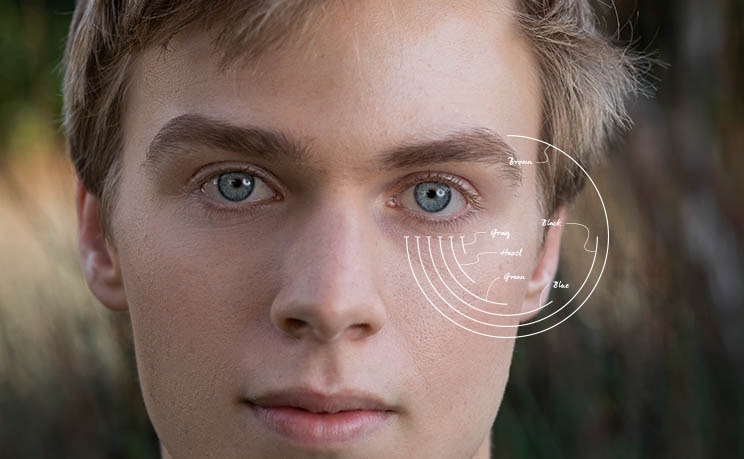AncestryDNA® Traits
Eye Color
Have you ever noticed how many different eye colors there are? All these different eye colors are formed by the same pigment: melanin.
Whether you have dark or light eyes depends almost entirely on genetics. Curious about the link between your eye color and your DNA? An AncestryDNA® + Traits test can tell you more about the role your genes play in your eye color.

How Many Eye Colors Are There?
Humans have a wide range of eye colors, although some are more common than others. These colors include blue, gray, green, and all the shades of brown—some so dark they almost look black. Hazel eyes typically include a blend of brown and green colors.
The more melanin that you have in your eyes—specifically in the stroma, one of the layers in the colored part of your eye known as the iris—the darker your eyes are.
Melanin comes in two varieties: eumelanin and pheomelanin. Eumelanin controls black and brown colors. Pheomelanin controls red and yellow hues. It's the mix of these two types of melanin that determines whether your eye color is coffee black, honey brown, hazel, or even green, for example.
Eye Color Genetics: Myths and Facts
Eye color used to be thought of as a pretty simple trait. Brown-eyed parents, it was thought, could have kids with any eye color—although they usually had brown-eyed kids. And blue-eyed parents, it was believed, could only have children with blue eyes. In this overly simple scenario, the brown eye color was "dominant" over the blue eye color.
It turns out that in real life, the determination of eye color—which is a physical characteristic known as a phenotype—is a bit more complicated. More often than this simple model in which brown eyes are dominant might predict, blue-eyed parents can have brown-eyed kids. This is because more than one gene is involved in the eye color trait.
How Many Genes Determine Your Eye Color?
There are dozens of eye color-related genes that scientists know of. And there are plenty more they don't know about yet.
AncestryDNA looks at over 7,000 DNA markers found in multiple genes linked to eye color. Your pattern at these genetic markers is what determines your eye color result.
Some people have markers linked only to light eye color. Some have markers tied only to dark color. And others have a combination of both light eye color markers and dark eye color markers.
Eye Color Fun Facts
Green eyes are the rarest eye color in the world’s population. The most common eye color in humans is brown.
It's likely that originally all humans had brown eyes. Around 6,000 to 10,000 years ago a genetic mutation popped up in the Black Sea region that likely led to blue eyes.
Brown eyes get their color from melanin, but blue eyes don't have any blue pigment. Instead, if you have blue eyes, the front part of your eye has hardly any pigment.
Why does the lack of pigment look blue? For the same reason the sky looks blue. Particles in the rest of your eye scatter blue more than the other colors of the rainbow, making your eyes appear blue.
References
Gudgel, Dan T. "Your Blue Eyes Aren’t Really Blue." American Academy of Ophthalmology. June 16, 2023. https://www.aao.org/eye-health/tips-prevention/your-blue-eyes-arent-really-blue.
Khan, Razib. "What Does Eye Color What does eye color have to do with skin color?" Discover Magazine. February 5, 2009. https://www.discovermagazine.com/the-sciences/what-does-eye-color-have-to-do-with-skin-color.
Liu, Fan, et al. "Eye Color and the Prediction of Complex Phenotypes from Genotypes." Current Biology. March 10, 2009. https://pubmed.ncbi.nlm.nih.gov/19278628/.
Manco, Jean. Ancestral Journeys: The Peopling of Europe from the First Venturers to the Vikings. 2nd ed. Thames & Hudson. 2015.
Pośpiech, Ewelina et al. "Gene–gene Interactions Contribute to Eye Colour Variation in Humans." Journal of Human Genetics. April 7, 2011. https://www.nature.com/articles/jhg201138.
Southworth, Lucy. "Eye Color." The Tech Museum of Innovation. Stanford University. September 21, 2007. http://genetics.thetech.org/ask/ask232.
"The World’s Population By Eye Color." World Atlas. Accessed July 3, 2023. https://www.worldatlas.com/articles/which-eye-color-is-the-most-common-in-the-world.html.